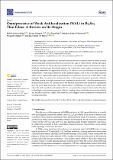Omnipresence of weak antilocalization (WAL) in Bi2Se3 thin films : a review on its origin
Abstract
Topological insulators are materials with time-reversal symmetric states of matter in which an insulating bulk is surrounded by protected Dirac-like edge or surface states. Among topological insulators, Bi2Se3 has attracted special attention due to its simple surface band structure and its relatively large band gap that should enhance the contribution of its surface to transport, which is usually masked by the appearance of defects. In order to avoid this difficulty, several features characteristic of topological insulators in the quantum regime, such as the weak-antilocalization effect, can be explored through magnetotransport experiments carried out on thin films of this material. Here, we review the existing literature on the magnetotransport properties of Bi2Se3 thin films, paying thorough attention to the weak-antilocalization effect, which is omnipresent no matter the film quality. We carefully follow the different situations found in reported experiments, from the most ideal situations, with a strong surface contribution, towards more realistic cases where the bulk contribution dominates. We have compared the transport data found in literature to shed light on the intrinsic properties of Bi2Se3, finding a clear relationship between the mobility and the phase coherence length of the films that could trigger further experiments on transport in topological systems.
Citation
Gracia-Abad , R , Sangiao , S , Bigi , C , Kumar Chaluvadi , S , Orgiani , P & De Teresa , J M 2021 , ' Omnipresence of weak antilocalization (WAL) in Bi 2 Se 3 thin films : a review on its origin ' , Nanomaterials , vol. 11 , no. 5 , e1077 . https://doi.org/10.3390/nano11051077
Publication
Nanomaterials
Status
Peer reviewed
ISSN
2079-4991Type
Journal item
Description
R.G.-A. acknowledges the financial support coming from the Diputación General de Aragón through a doctoral fellowship. The authors acknowledge the H2020 NFFA-Europe project 654360 and the CNR-IOM TASC Laboratory.Collections
Items in the St Andrews Research Repository are protected by copyright, with all rights reserved, unless otherwise indicated.

